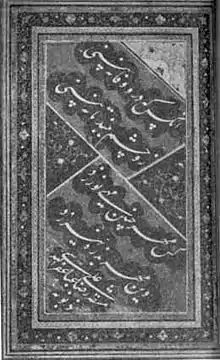Ali Reza Abbasi Tabrizi | |
|---|---|
 A Chalipa in Nastaʿlīq script by Ali Reza Abbasi | |
| Born | Late 1500's |
| Died | 1600's |
| Nationality | Persian |
| Occupation(s) | Calligrapher and calligraphy teacher |
Ali Reza Abbasi Tabrizi was a prominent Persian[1] calligrapher and calligraphy teacher, who flourished in 16th-17th century Safavid Iran.[2] He was titled by Abbas I as Šāhnavāz Xān. Abbasi was a master of Naskh and Thuluth scripts and the initiator of his own style of Nastaʿlīq script. Besides he was an expert of various other scripts like Muhaqqaq, Reqa, Reyhan, Tevki and Taʿlīq scripts.[3]
Youth
Ali Reza Abbasi started learning calligraphy in Tabriz as a pupil of Mohammad Hossein Tabrizi and Ala Beyk. Abbasi obtained an outstanding knowledge of Thuluth and Naskh scripts. After that the Ottomans occupied Tabriz in the era of Mohammad Khodabanda, Abbasi left the city and went to Qazvin, the capital of the Safavid dynasty. He lived there in the Jameh mosque of Qazvin. He worked as a calligrapher and completed some parts of inscriptions of the mosque and also some Koran samples. His works on the Jameh mosque of Qazvin made him famous. In the early years of the reign of Abbas I, he was in Farhad Khan's employ, who was an important Sardar of the Safavids and his rank and dignity was increasing under Abbass I. When Sardar Farhad Khan noticed that Alireza Abbasi was an able artist, he appointed him as his personal companion and took Abbasi as his companion to Khorasan and Mazandaran.[4]
In the court of Safavids
Alireza Abbasi's fame increased. On the 1st of July 1593 Abbasi became the King's intimate friend and the King instructed some of calligraphers like Mohammad Reza Emami, Mohammad Saleh Esfahani and Abd ol-Baghi Tabrizi to teach Abbasi Thuluth script.[5]
He had a son named Badi al-Zaman Tabrizi.[6]
Abbasi's death date in unknown, but it is supposed that he died towards the end of Safi's era.
References
- ↑ Afsari, Hamid Reza; Melvin-Koushki, Matthew (2008). "ʿAlī Riḍā ʿAbbāsī". In Madelung, Wilferd; Daftary, Farhad (eds.). Encyclopaedia Islamica Online. Brill Online. ISSN 1875-9831.
- ↑ Soucek, P. P. (1985). "ʿALĪ-REŻĀ ABBĀSĪ". In Yarshater, Ehsan (ed.). Encyclopædia Iranica, Volume I/8: Alafrank–Alp Arslan. London and New York: Routledge & Kegan Paul. p. 880. ISBN 978-0-71009-097-3.
- ↑ Mohammad Naghshi Tabrizi: Hayāt e Alireza Abbasi, Xošnevis e maruf e dore ye Safaviye (The life of Ali Reza Abbasi, the famous calligrapher in the Safavid era). In: Honar o Mardom(Art and People). volume 2, Nr. 20, 1964, S. 30–31.
- ↑ "گروه آموزش هنر مدارس بروجرد".
- ↑ "آموزشی و علمی".
- ↑ Alizadeh, Mahbanoo; Zand, Roxane (2013). "Badīʿ al-Zamān Tabrīzī". In Madelung, Wilferd; Daftary, Farhad (eds.). Encyclopaedia Islamica Online. Brill Online. ISSN 1875-9831.